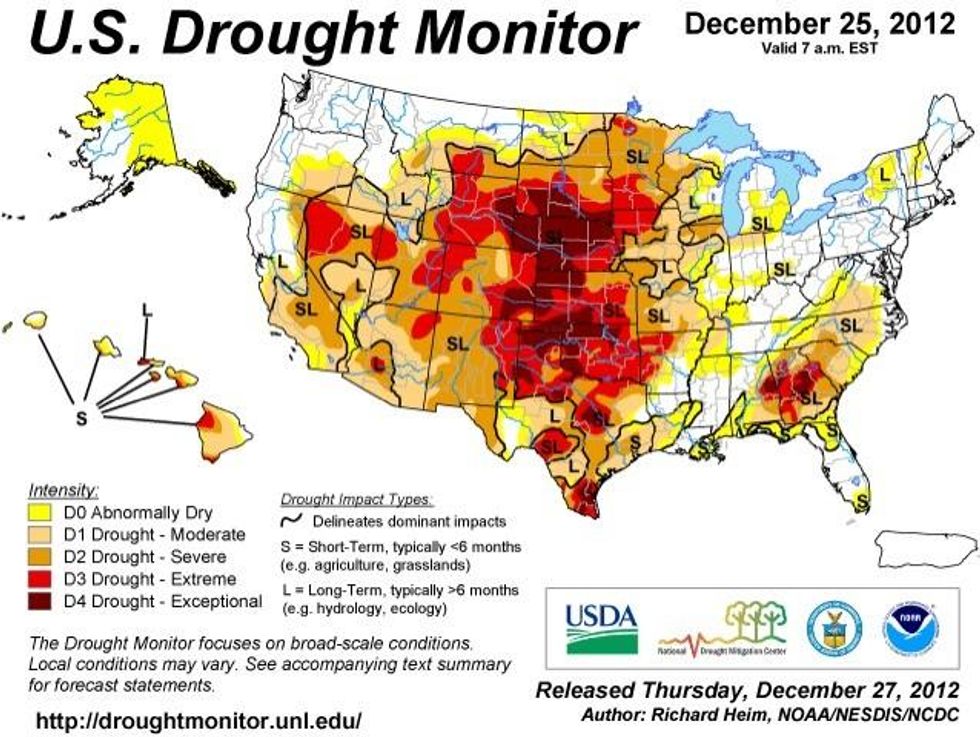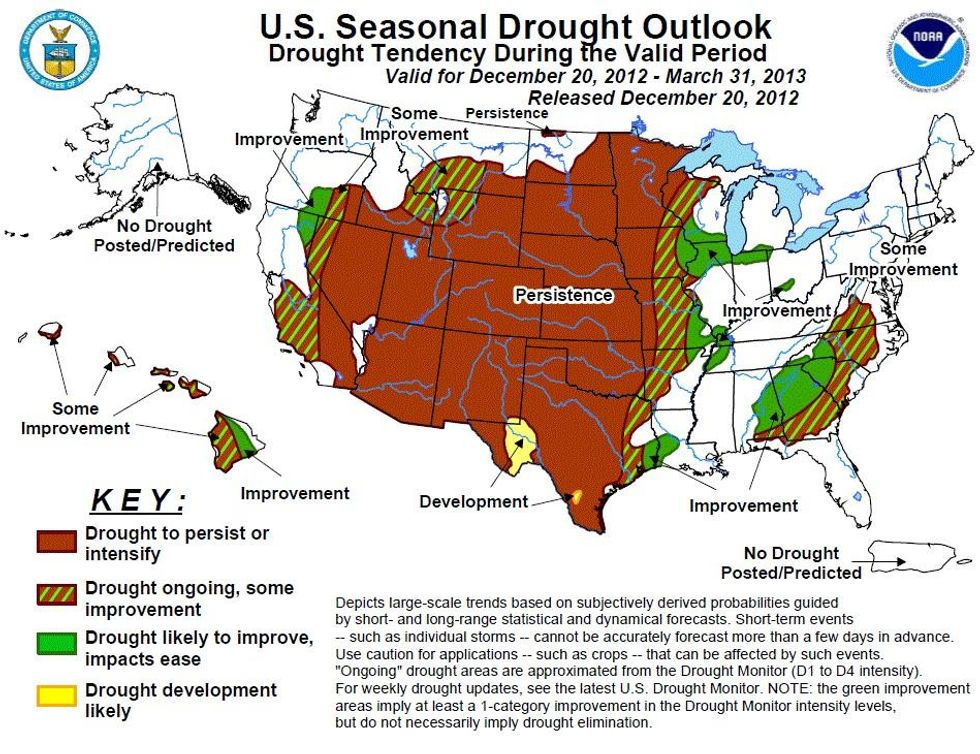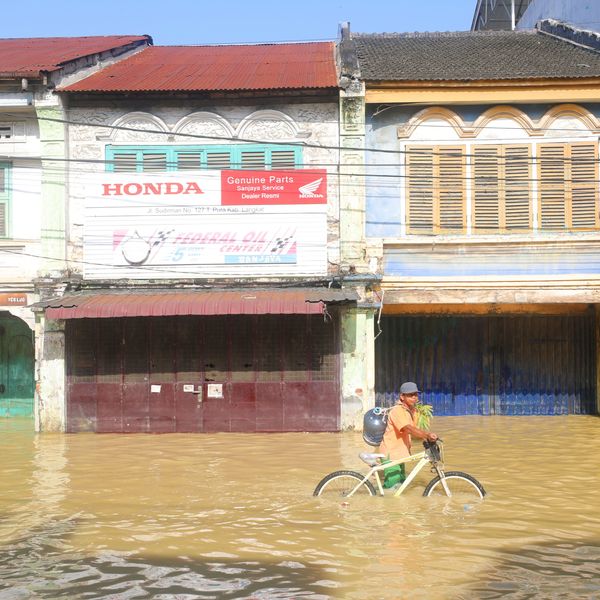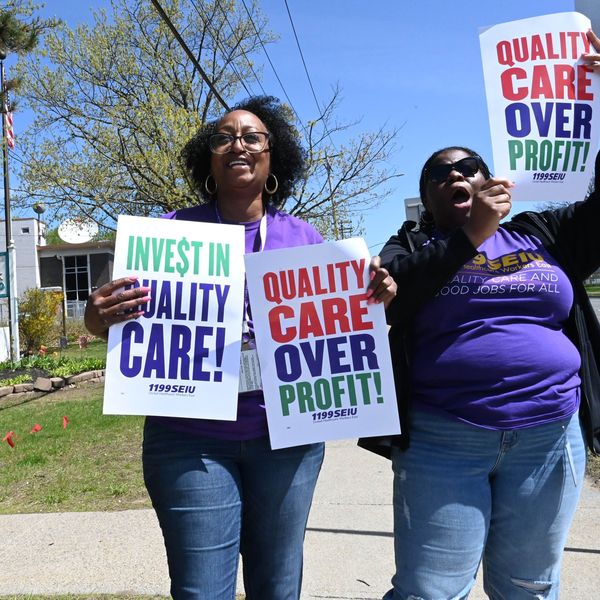Recent Storms Recall Dust Bowl Days as Drought Persists
2012's record drought set to continue into 2013
As the devastating drought of 2012 looks set to continue into 2013, recent storms in parched areas of the country are bringing visions of the Dust Bowl to some residents.
Reuters reports:
Residents of the Great Plains over the last year or so have experienced storms reminiscent of the 1930s Dust Bowl. Experts say the new storms have been brought on by a combination of historic drought, a dwindling Ogallala Aquifer underground water supply, climate change and government farm programs. [...]
While few people believe it could get that bad again, the new storms have some experts worried that similar conditions -- if not the catastrophic environmental disaster of the 1930s -- are returning to parts of Texas, Oklahoma, New Mexico, Kansas and Colorado.
The most recent Drought Monitor released on Thursday shows massive areas of the country still suffering under a drought, with 61.8% of the contiguous United States under moderate to severe levels of drought.

Weather Underground co-founder Dr. Jeff Masters remarks that data now show the "2012 drought the greatest U.S. drought since the Dust Bowl year of 1939."
And the drought forecast shows 2012's drought moving right into 2013:

"I hope we don't talk ourselves into complacency with easy assumptions that a Dust Bowl could never happen again," Reuters reports Craig Cox, agriculture director for Environmental Working Group, as saying. "Instead, we should do what it takes to make sure it doesn't happen again."
An Urgent Message From Our Co-Founder
Dear Common Dreams reader, The U.S. is on a fast track to authoritarianism like nothing I've ever seen. Meanwhile, corporate news outlets are utterly capitulating to Trump, twisting their coverage to avoid drawing his ire while lining up to stuff cash in his pockets. That's why I believe that Common Dreams is doing the best and most consequential reporting that we've ever done. Our small but mighty team is a progressive reporting powerhouse, covering the news every day that the corporate media never will. Our mission has always been simple: To inform. To inspire. And to ignite change for the common good. Now here's the key piece that I want all our readers to understand: None of this would be possible without your financial support. That's not just some fundraising cliche. It's the absolute and literal truth. We don't accept corporate advertising and never will. We don't have a paywall because we don't think people should be blocked from critical news based on their ability to pay. Everything we do is funded by the donations of readers like you. Will you donate now to help power the nonprofit, independent reporting of Common Dreams? Thank you for being a vital member of our community. Together, we can keep independent journalism alive when it’s needed most. - Craig Brown, Co-founder |
As the devastating drought of 2012 looks set to continue into 2013, recent storms in parched areas of the country are bringing visions of the Dust Bowl to some residents.
Reuters reports:
Residents of the Great Plains over the last year or so have experienced storms reminiscent of the 1930s Dust Bowl. Experts say the new storms have been brought on by a combination of historic drought, a dwindling Ogallala Aquifer underground water supply, climate change and government farm programs. [...]
While few people believe it could get that bad again, the new storms have some experts worried that similar conditions -- if not the catastrophic environmental disaster of the 1930s -- are returning to parts of Texas, Oklahoma, New Mexico, Kansas and Colorado.
The most recent Drought Monitor released on Thursday shows massive areas of the country still suffering under a drought, with 61.8% of the contiguous United States under moderate to severe levels of drought.

Weather Underground co-founder Dr. Jeff Masters remarks that data now show the "2012 drought the greatest U.S. drought since the Dust Bowl year of 1939."
And the drought forecast shows 2012's drought moving right into 2013:

"I hope we don't talk ourselves into complacency with easy assumptions that a Dust Bowl could never happen again," Reuters reports Craig Cox, agriculture director for Environmental Working Group, as saying. "Instead, we should do what it takes to make sure it doesn't happen again."
As the devastating drought of 2012 looks set to continue into 2013, recent storms in parched areas of the country are bringing visions of the Dust Bowl to some residents.
Reuters reports:
Residents of the Great Plains over the last year or so have experienced storms reminiscent of the 1930s Dust Bowl. Experts say the new storms have been brought on by a combination of historic drought, a dwindling Ogallala Aquifer underground water supply, climate change and government farm programs. [...]
While few people believe it could get that bad again, the new storms have some experts worried that similar conditions -- if not the catastrophic environmental disaster of the 1930s -- are returning to parts of Texas, Oklahoma, New Mexico, Kansas and Colorado.
The most recent Drought Monitor released on Thursday shows massive areas of the country still suffering under a drought, with 61.8% of the contiguous United States under moderate to severe levels of drought.

Weather Underground co-founder Dr. Jeff Masters remarks that data now show the "2012 drought the greatest U.S. drought since the Dust Bowl year of 1939."
And the drought forecast shows 2012's drought moving right into 2013:

"I hope we don't talk ourselves into complacency with easy assumptions that a Dust Bowl could never happen again," Reuters reports Craig Cox, agriculture director for Environmental Working Group, as saying. "Instead, we should do what it takes to make sure it doesn't happen again."

